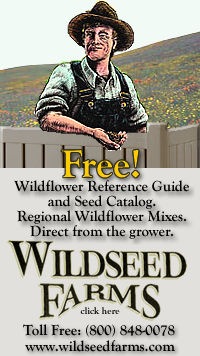Search
For The Answer
Click here to access our database of
Plant Answers
Search
For The Picture
Click here to access the Google database of plants
and insects
Milberger's Nursery and Landscaping
3920 North Loop 1604 E.
San Antonio, TX 78247
210.497.3760
nursery@milbergersa.com

Three exits east of 281, inside of 1604
Next to the Diamond Shamrock station
Please click map for more detailed map and driving directions.

Saturday, September 30, 2001
Submitted by Calvin Finch,
Ph.D., Director of Conservation, SAWS, and Horticulturist
WILDSCAPING
Last weekend I joined 100 other volunteers in planting the new San Pedro Park/KSTX Butterfly Garden. San Pedro Park is the second oldest park (Boston Common is oldest) in the United States. It is the location of the San Pedro Springs that attracted generations of Native Americans to the area and was a center of early European settlement. The butterfly garden is adjacent to the springs on the North side.
The Springs figure prominently in San Antonio water history, so it is appropriate that the butterfly garden be close by. Plantings like the butterfly garden need to be utilized to replace lawn grass if San Antonio is going to meet its long-term water challenge without sacrificing lush landscapes. The native and well-adapted plants used at the San Pedro Park/KSTX Butterfly Garden will survive without supplemental watering and will perform at peak levels with about one-fourth as much water as a St. Augustine lawn.
The San Pedro Butterfly Garden includes many species of plants. In addition to low water requirements, the plants were selected to provide nectar and foliage to feed a wide variety of butterflies.
Among the featured plants at the garden are ornamental grasses. Grasses bloom in the fall, winter, spring and summer, depending on the species. The inconspicuous blooms are important to butterflies and the larvae feed on the foliage. Last weekend I rediscovered one of my favorite ornamental grasses, ‘Autumn Blush’ muhly grass. Muhly grass blooms in the fall and this selection has a beautiful pink seed spray that is attractive through most of the winter. In the spring, cut the dry foliage back and a new crop of blades will emerge to form a disciplined clump that lends itself to natural or formal plantings.
Lantanas are an important part of any butterfly garden. The San Pedro/KSTX Butterfly Garden includes the lavender lantana (Lantana montevedensis). Lavender lantana is a spreading plant that makes a good groundcover or container plant. It blooms steadily from mid spring to late winter, if the winter is mild. Peak bloom periods occur in late spring and early fall. Many species of butterflies like the small blooms as a nectar source. Though the flowers look flat, they are tubular. The clusters of tubular blooms are shallow enough for butterflies but also attract hummingbirds. Most lantanas die back when cold weather arrives, but lavender lantana stays evergreen most winters. It is not as aggressive a grower as ‘New Gold’ or the upright lantanas and thus does not seem prone to the legginess that forces gardeners to cut other lantanas back every year.
The garden plan was donated by Kim Wolfe of RVK Landscape Architects. It was planned to provide both nectar-producing plants for adult butterflies and foliage plants for caterpillars. An effective butterfly garden provides food over a long season. In addition to lavender lantana and muhly grass, the garden includes the following plants:
Salvia greggi, esperanza, ‘Irene’ and ‘New Gold’ lantana, Texas redbud, agarita, American beautyberry, Texas mountain laurel, Mexican plum, queen’s crown, red yucca, cenizo, Turk’s cap, rosemary, brown-eyed Susan, mealy blue sage, Mexican bush sage, esperanza, butterfly weed, chili petin, gray contoneaster, sotol, Barbados cherry, prickly pear, passion flower, prairie rye, and buffalo grass.
In addition to San Antonio Parks & Recreation, Kim Wolfe and KSTX Radio, Garden-Ville, Wolfe Nursery, Milbergers, Texas Parks & Wildlife, San Antonio Credit Union, Peerless Farms, Color Spot Nursery, Mortellaro’s Nursery, San Antonio Botanical Gardens, Green Light Co., Schultz Nursery, Green Gate Nursery, McTurf, Hall Irrigation, Master Naturalists, Master Gardeners, and SAWS were partners in the effort.
For more information on butterfly gardening, send a self-addressed stamped envelope (.55 cent stamp, No. 10 envelope) to Wildscape, SAWS Conservation Dept., 1001 E. Market, San Antonio, TX 78205. Internet users can search for the butterfly gardening information and connect with the San Antonio Botanical Gardens at http://www.sabot.org/natives/butterfly.html or for a book seek out “Butterfly Gardening for the South” by Geyata Ajilvsgi. Also in bookstores, look for “Texas Wildscapes” by Demude and Bender.


